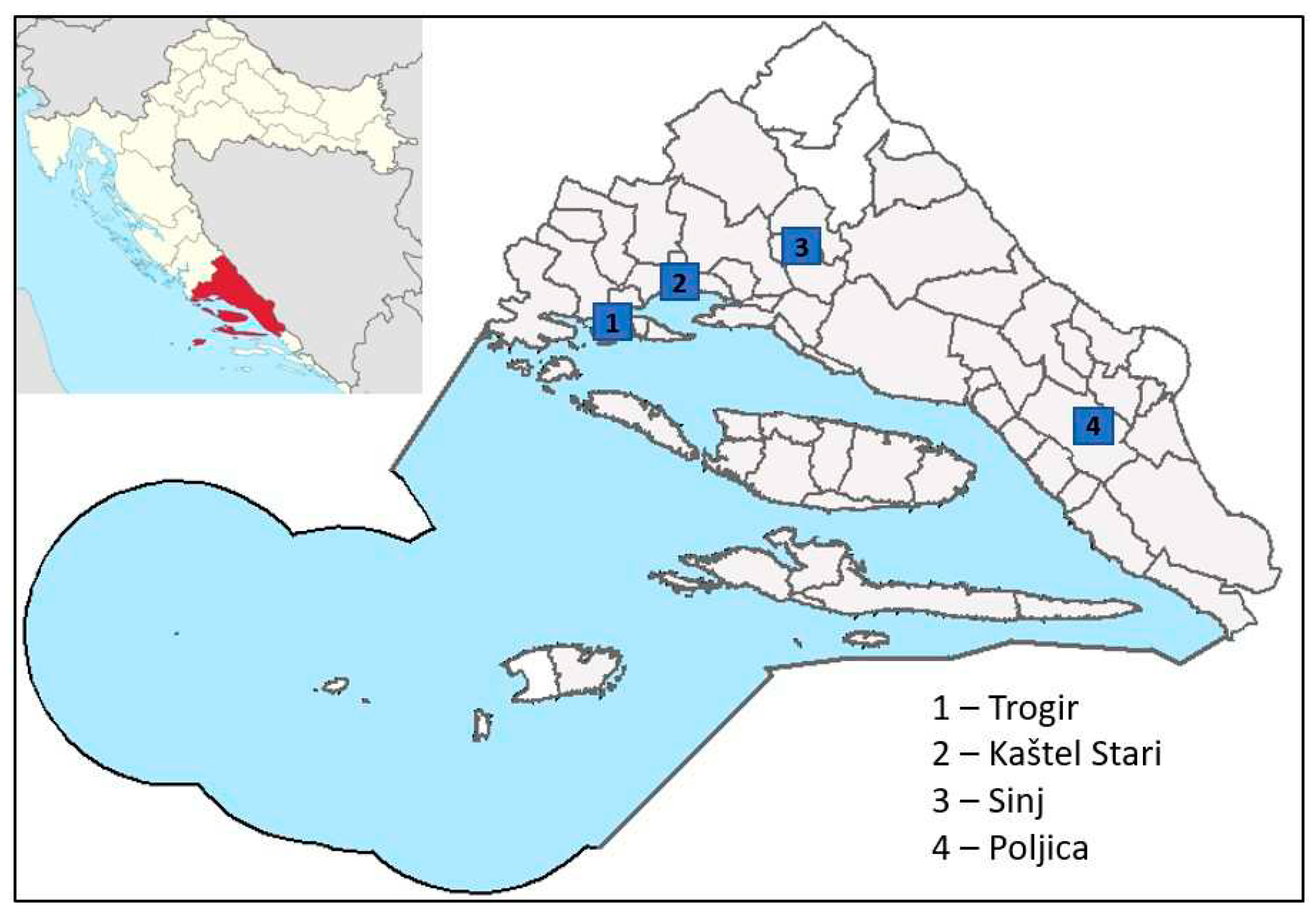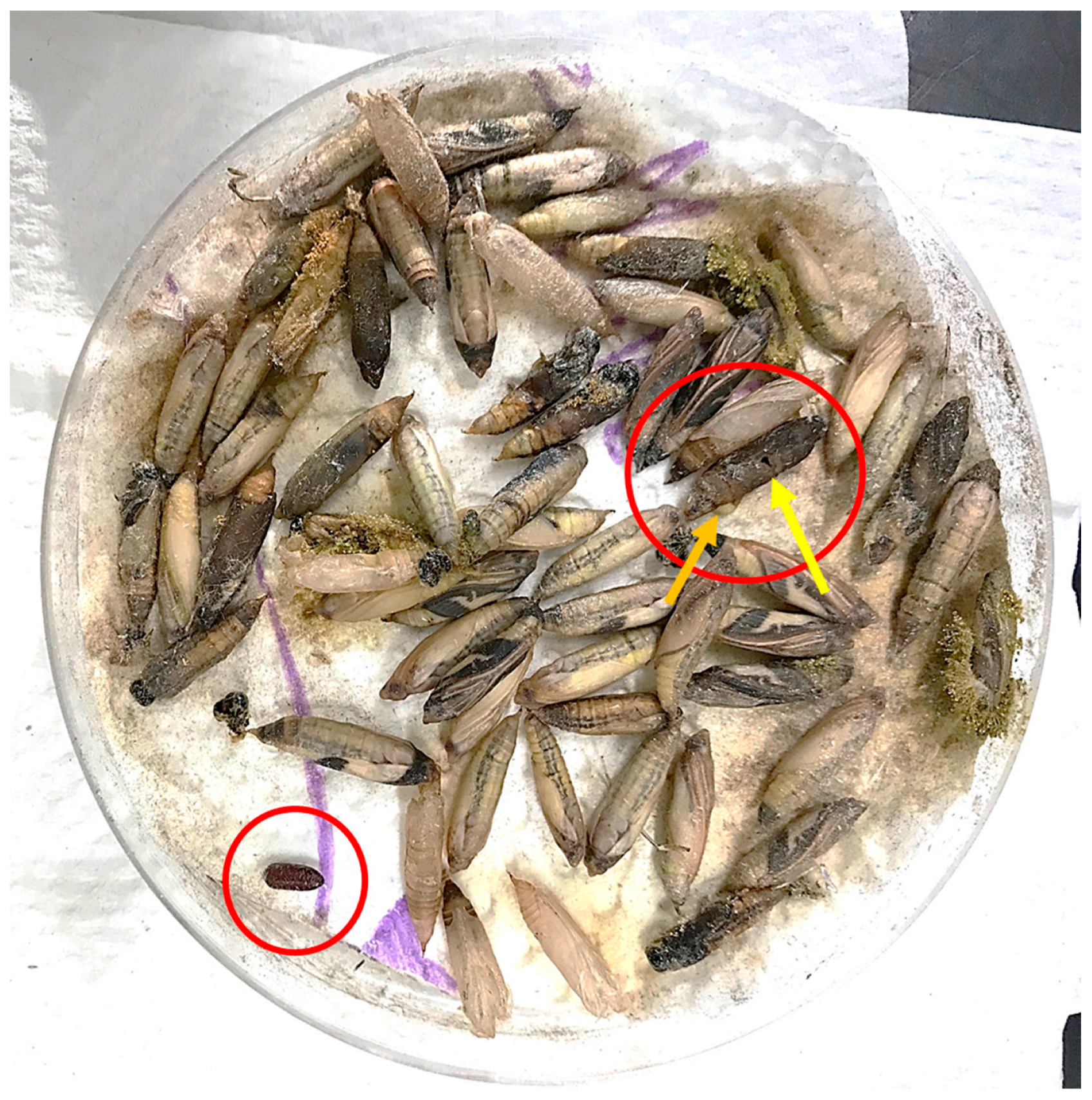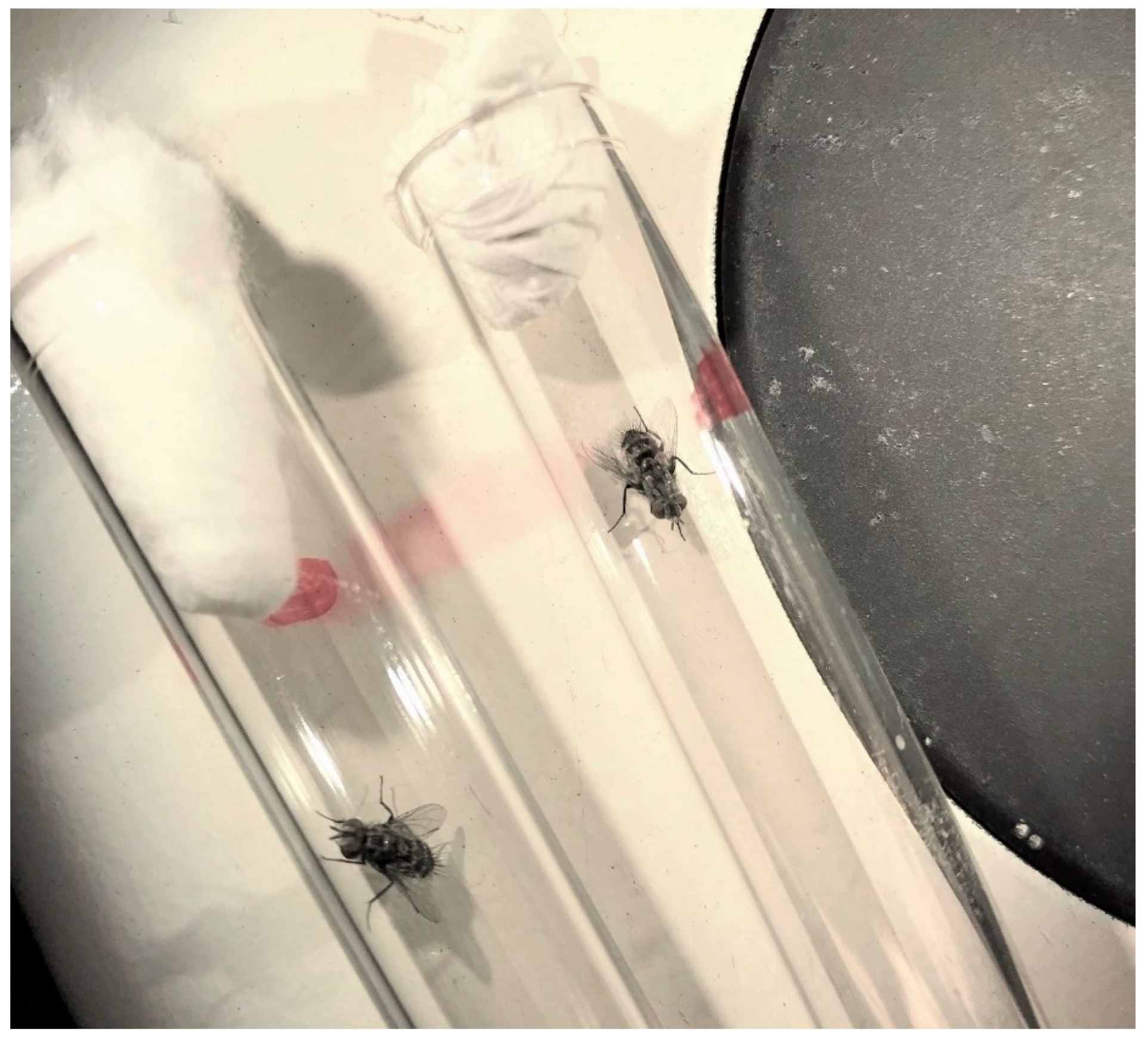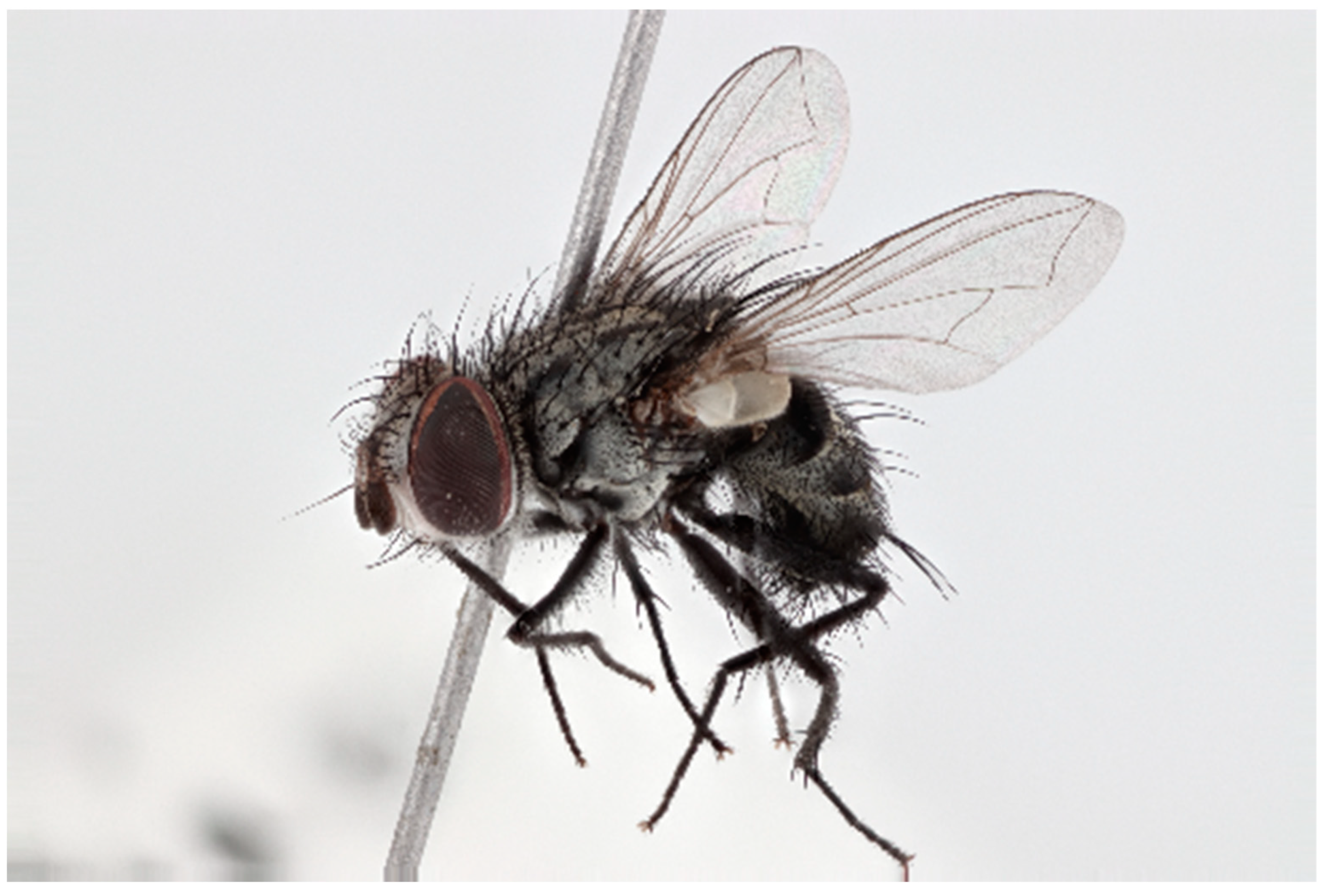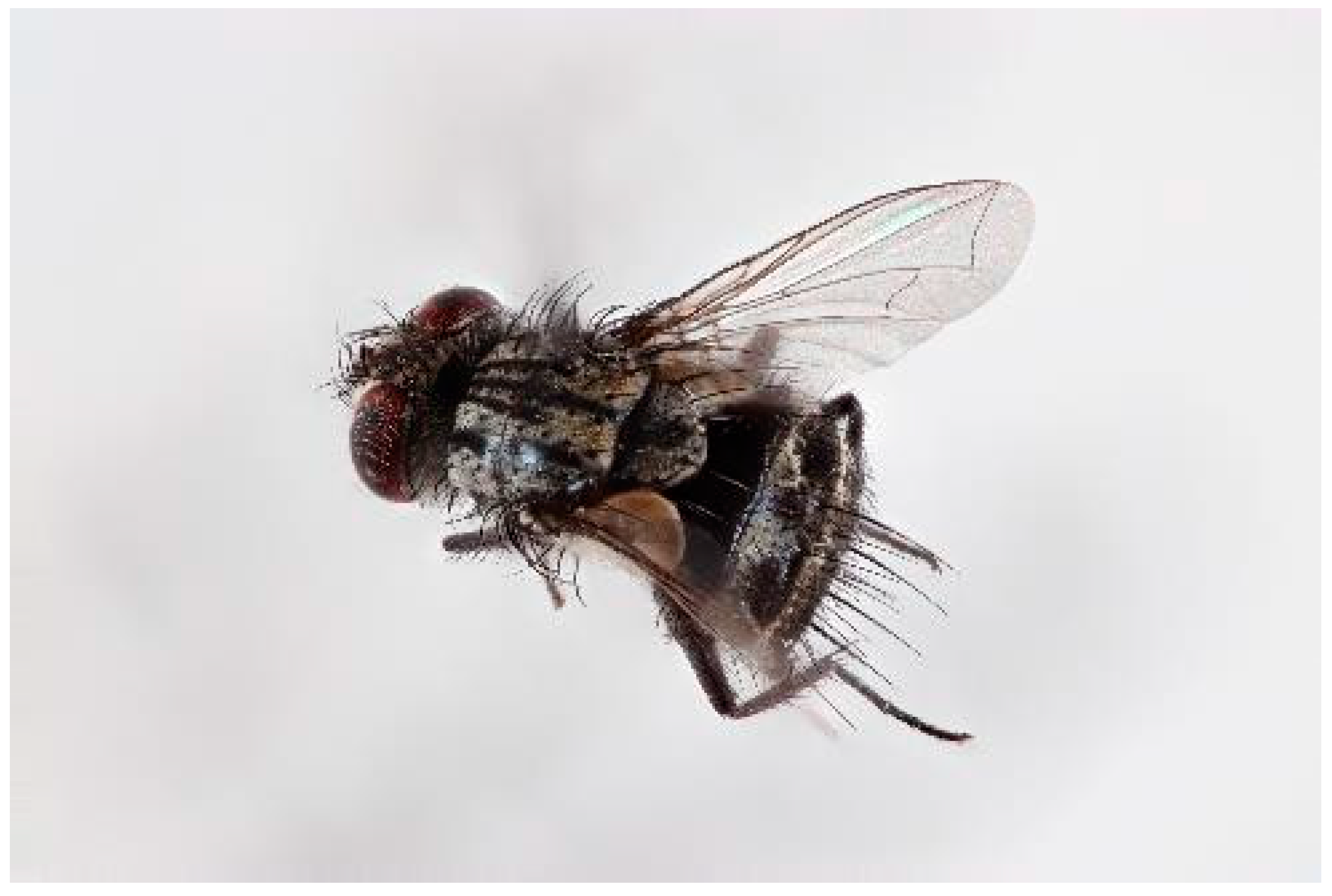1. Introduction
A non-native species with negative ecological, economic, or health consequences is called an invasive alien species [
1]. Biological invasions are considered a major threat to biodiversity and the functioning of natural ecosystems [
2]. Box tree moth,
Cydalima perspectalis (Walker 1859) (Lepidoptera, Crambidae), is one such species native to eastern and southern Asia where it is a native pest of
Buxus trees [
3,
4]. Its natural distribution includes China, Japan, Korea and India [
4]. This pest was accidentally introduced to Europe through the trade in box tree,
Buxus spp. where it can cause considerable damage [
5]. The invasive characteristic of
C. perspectalis has been clearly demonstrated by its rapid spread and establishment along the European Union countries after its first detection in southwestern Germany and in the Netherlands in 2007 [
6,
7].
Cydalima perspectalis has subsequently continued to spread, and has been identified in Switzerland, France, Austria, Belgium, Czech Republic, England, Hungary, Italy Liechtenstein, Slovakia, Slovenia, Croatia, Romania and Turkey [
3,
8,
9]. This pest has been a serious problem in Croatia since its arrival in 2013, causing significant damage on
B. sempervirens plants [
10].
In the native range of
C. perspectalis, which is South and East Asia [
11], there are already data on the occurrence of natural parasitoids of
C. perspectalis, three of which belong to the order Diptera (larval parasitoids) and seven to the order Hymenoptera (egg, larval and pupal parasitoids) [
4]. Within the order Diptera, three tachinids (Tachinidae) are known to parasitize larvae of
C. perspectalis, including
Exorista sp. a parasitoid that can cause up to 47.4% of larval and pupal mortality, and two highly polyphagous parasitoids,
Pseudoperichaeta nigrolineata (Walker 1853) and
Compsilura concinnata (Meigen 1824) [
4].
Data on opportunistic parasitoids of
C. perspectalis on the European continent include
P. nigrolineata, a tachinid fly reported from Switzerland [
4] that parasitizes larvae of
C. perspectalis,
Stenomalina cf.
communis (Ness 1834) (Hymenoptera, Pteromalidae), a parasitoid wasp in Britain [
5], and
Apechthis compunctator (L.) (Hymenoptera, Ichneumonidae), a pupal parasitoid reported from Switzerland [
4]. Studies in natural boxwood forests in France and Spain report parasitization by the tachinid fly
C. concinnata [
12,
13].
According to Fauna Europaea [
14], all three tachinid species (
P. nigrolineata,
S. communis and
C. concinnata) are widely distributed on the European continent and are therefore presumed to range in Croatia. However, so far there has been no evidence of natural enemies of
C. perspectalis in Croatia [
10]. In addition to the identified parasitoids, laboratory studies on eight
Trichogramma species showed potential for the highly polyphagous
Trichogramma brassicae Bezdenko 1968 and
Trichogramma dendrolimi Matsumura 1926 (Hymenoptera, Trichogrammatidae) as biological control agents, based on their ability to locate and reproduce on eggs of
C. perspectalis [
15]. Beneficial predators such as
Chrysoperla carnea (Stephens 1836) (Neuroptera, Chrysopidae) and
Orius majusculus (Reuter 1879) (Heteroptera, Anthocoridae) have been observed preying on
C. perspectalis eggs [
16] and therefore, conserving natural enemies like
O. majusculus and implementing the release of beneficial insects like
C. carnea can be considered as supportive tools in the biological control of
C. perspectalis [
16].
Identifying potential biological control agents of C. perspectalis in both the native and introduced ranges of the pest is of considerable importance when a biological control program is being considered for an invasive pest. Here we report on a parasitic insect not previously known to attack C. perspectalis.
2. Materials and Methods
Field collection of mature larvae and pupae of
C. perspectalis was conducted on 22
nd –30
th July 2020 in four locations in Split – Dalmatia County in Croatia (
Figure 1). Larvae and pupae were collected on naturally infested
B. sempervirens individual plants or hedgerows in private house gardens. These preimaginal stages were progeny of the second adult generation, and the purpose of field collection was to establish a laboratory colony.
Fresh pupae from location Poljica were sent by bonded air carrier and delivered to USDA APHIS PPQ S&T Forest Pest Methods Laboratory (FPML) in Massachusetts, USA on August 21, 2020, while larvae from other locations were transferred to the laboratory of University of Split for pupation. The shipped pupae remained in transit for 7 days before delivery to FPML. Upon reception of the insect material in FPML, it was observed that one
C. perspectalis pupa had an exit hole and a live tachinid larva next to it (which pupariated immediately (< 1 hour), while another tachinid larva had emerged and pupariated during shipment (
Figure 2). The puparia were held individually in glass vials plugged with cotton. On August 30, two adult tachinids emerged (
Figure 3). They were pinned and delivered to the Natural History Museum in United Kingdom for identification.
3. Results
From four collection sites, two specimens of Diptera emerged from pupae of
C. perspectalis collected at Poljica (
Table 1). Of the 83 moth pupae sent to FPML from Poljica, 9 adults emerged in transit, 53 emerged in the lab, 20 died in transit of unknown causes, and the remaining pupa was determined to have been parasitized. We cannot be certain whether both tachinids emerged from one or two hosts because mold may have concealed an exit hole in another dead pupa; an examination of the dead pupae under a dissecting microscope did not reveal an additional exit hole. Dead pupae were not dissected to determine if they were parasitized. Conservatively, therefore, 1.2 – 2.4 % parasitism rate was achieved.
The tachinid specimens were identified at the Natural History Museum (NHM), London, UK, as Nemorilla floralis (Fallén, 1810) (Diptera, Tachinidae). Specimens were photographed and deposited at NHM.
4. Discussion
Data on the occurrence of natural enemies and their impact on the population reduction of
C. perspectalis are predominantly reported in its native range of South and East Asia [
4,
11]. In Asia,
C. perspectalis has several natural enemies, including two egg parasitoids, five larval parasitoids, and two pupal parasitoids belonging to the Tachinidae, Braconidae, Chalcididae, Encyrtidae, and Ichneumonidae [
4]. Natural enemies in Europe include the tachinid
P. nigrolineata, the pteromalid
S. communis, and the ichneumonid
A. compunctator [
5,
8]. Studies in natural boxwood forests in France have reported 1.83% parasitization by the tachinid fly
C. concinnata [
12].
Compsilura concinnata was the only parasitoid to emerge from 800 5
th and 6
th instar larvae collected over 5 years in Catalonia, Spain; parasitism rates at six locations ranged from 0 to 20% [
13]. In that study, 0.5% of 42 larvae that died before pupation were found to be infected by a strain of the fungus
Beauveria bassiana (Bals. -Criv.) Vuill., 1912 (Ascomycota: Hypocreales), another potential control agent [
13]. In this research, we confirm that at least 1.2 – 2.4 % parasitism rate was achieved by
N. floralis, depending on whether one or two hosts had been parasitized and whether other tachinids in the collection had died in transit along with their hosts.
Nemorilla floralis is native to the Palearctic region, where it is reported to be widely distributed in central and western Europe and Scandinavia.
Nemorilla floralis presence has been confirmed in Croatia [
17] and neighboring countries too [
18].
It is an endoparasitoid of larvae of almost twenty moth species but so far there is no record of its parasitism on
C. perspectalis [
19].
C. perspectalis was only recently found in Africa [
20] and North America [
21,
22]. Due to the short recent history of
C. perspectalis invasion in over 40 countries of Europe, Middle East, Africa and North America [
23], and the significant number of other hosts parasitized by
N. floralis, further discovery of parasitism of
C. perspectalis larvae by
N. floralis is likely to occur in the fly’s native range in other parts of Europe.
5. Conclusions
This is the first record of N. floralis parasitism on C. perspectalis larvae. This common and generalist parasitoid may potentially augment biological control of C. perspectalis in Europe.
Author Contributions
Conceptualization, MB, GS, HN; methodology, HN, CR; validation, CR.; investigation, ARA, MB, HN; data curation, CR, HN; writing—original draft preparation, MB, ARA, HN; writing—review and editing, GS, HN, CR; visualization, CR. All authors have read and agreed to the published version of the manuscript.”
Funding
This research was supported as part of the North American Plant Protection Organization (NAPPO) - United States Department of Agriculture’s Animal and Plant Health Inspection Service (APHIS) project: Development of SIT and IPM tools to eradicate Box Tree Moth (BTM – Cydalima perspectalis) incursions into the United States, under Cooperative Agreement AP22PPQS&T00C016. It may not necessarily express APHIS’ views.
Acknowledgments
Authors acknowledge Florin Feneru (Natural History Museum, London) for pictures of the specimen and to Pierfilippo Cerretti (Sapienza University of Rome) for consultation on specimen identification.
Conflicts of Interest
The authors declare no conflict of interest.
References
- McNeely, J. Invasive Species: A Costly Catastrophe for Native Biodiversity. Land Use and Water Res. Res. 2001, 2, 1–10. [Google Scholar]
- Simberloff, D. Invasive species, what everyone needs to know; Oxford University press: Oxford, UK, 2013; pp. 1–329. [Google Scholar]
- Kenis, M. S.; Nacambo, F.L.G.; Leuthardt, F.; Di Domenico, T.; Haye, M. The box tree moth, Cydalima perspectalis, in Europe: horticultural pest or environmental disaster? Aliens 2013, 33, 38–41. [Google Scholar]
- Wan, H. T.; Haye, M.; Kenis, S.; Nacambo, Z.; Xu, S.; Li, H. Biology and natural enemies of Cydalima perspectalis in Asia. Is there biological control potential in Europe? J. App. Ent. 2014, 138, 715–722. [Google Scholar] [CrossRef]
- Bird, S.; Raper, C.; Dale-Skey, N.; Salisbury, A. First records of two natural enemies of box tree moth, Cydalima perspectalis (Lepidoptera, Crambidae), in Britain. Brit. J. Ent. Nat. Hist. 2020, 33, 67–70. [Google Scholar]
- Kruger, E.O. Glyphodes perspectalis (Walker, 1859) – Neu für die Fauna Europas (Lepidoptera: Crambidae). Ent. Zeitsch. Insekten-Börse 2008, 118, 81–83. [Google Scholar]
- Van der Straten, M.J.; Muss, T.S.T. The box tree pyralid, Glyphodes perspectalis (Lepidoptera: Crambidae), an invasive alien moth ruining box trees. In Proceedings of the Netherlands Entomological Society, Amsterdam, Netherlands, 18 December 2009; 21, pp. 107–111. [Google Scholar]
- Nacambo S. Parasitisme, développement, modèe climatique et impact de Cydalima perspectalis en Europe. MSc-thesis, University of Neuchâtel, Switzerland, 2012.
- Nacambo, S.; Leuthardt, F. L. G.; Wan, H. H.; Li, H. M.; Haye, T.; Baur, B.; Weiss, R. M.; Kenis, M. Development characteristics of the box-tree moth Cydalima perspectalis and its potential distribution in Europe. J. App. Ent. 2013, 138, 14–26. [Google Scholar] [CrossRef]
- Matošević, D. Box tree moth (Cydalima perspectalis, Lepidoptera; Crambidae), new invasive insect pest in Croatia. South-east European forestry 2013, 4, 89–94. [Google Scholar] [CrossRef]
- Mally, R.; Nuss, M. Phylogeny and nomenclature of the box tree moth, Cydalima perspectalis (Walker, 1959) which was recently introduced in Europe (Lepidoptera: Pyraloidea: Crambidae: Spilomeilinae). Europ. J. Ent. 2010, 107, 393–400. [Google Scholar] [CrossRef]
- Morel, E.; Capelli, M.; de Bodard, M.; Colombel, E.; Michel, T. Research for native parasites and predators of the box tree moth Cydalima perspectalis, in natural boxwood forest in France. J. Int. Sci. Pub.: Agriculture & Food 2021, 9, 231–242. [Google Scholar]
- López, C.; Las Heras, S.; Garrido-Jurado, I.; Quesada-Moraga, E.; Eizaguirre, M. Survey of natural enemies of the invasive boxwood moth Cydalima perspectalis in southwestern Mediterranean Europe and biocontrol potential of a native Beauveria bassiana (Bals.-Criv.) Vuill. strain. Insects 2022, 13, 781. [Google Scholar] [CrossRef] [PubMed]
- Fauna Europaea, Natural History Museum Berlin. Available online: https://fauna-eu.org (accessed on 26.09.2023).
- Göttig, S.; Herz, A. Are egg parasitoids of the genus Trichogramma (Hymenoptera: Trichogrammatidae) promising biological control agents for regulating the invasive box tree pyralid, Cydalima perspectalis (Lepidoptera: Crambidae)? Biocontrol Sci. Technol. 2016, 26, 1471–1488. [Google Scholar] [CrossRef]
- Herz, A.; Göttig, S. Eco-friendly regulation of the box-tree pyralid Cydalima perspectalis. In Proceedings of the IUFRO Conference “Population Dynamics and Integrated Control of Forest Defoliating and Other Insects”, Sopot, Poland, 28 September - 2 October 2015; pp. 1–24. [Google Scholar]
- Lutovinovas, E.; Ozimec, R.; Barták, M.; Kokan, B. An updated checklist of Croatian Tachinidae (Diptera). Natura Croatica 2018, 27, 57–95. [Google Scholar] [CrossRef]
- Stanković, S.; Žikić, S.; Ilić Milošević, V.; Ritt, M.; Tschorsnig, H.P. Tachinid fauna of Serbia and Montenegro updated with new findings (Diptera: Tachinidae). J. Ent. Res. Soc. 2018, 20, 53–66, https://www.entomol.org/journal/index.php/JERS/article/view/1401. [Google Scholar]
- Encyclopedia of Life, Smithsonian Institution’s National Museum of Natural History. Available online: https://eol.org/pages/728643 (accessed on 26.09.2023).
- Haddad, K.; Kalaentzis, K.; Demetriou, J. On track to becoming a cosmopolitan invasive species: First record of the box tree moth Cydalima perspectalis (Lepidoptera: Crambidae) in the African continent. Ent. Hellenica 2020, 29, 27–32. [Google Scholar] [CrossRef]
- Wiesner, A.; Llewellyn, J.; Smith, S.M.; Scott-Dupree, C. Biology and distribution of box tree moth (Cydalima perspectalis) (Walker, 1859) in southern Ontario. In Proceedings of the 1st International Electronic Conference on Entomology, Basel, Switzerland, 1–15 July 2021. [Google Scholar] [CrossRef]
- Coyle, D.R.; Adams, J.; Bullas-Appleton, E.; Llewellyn, J.; Rimmer, A.; Skvarla, M.J.; Smith, S.M; Chong, J.H. Identification and management of Cydalima perspectalis (Lepidoptera: Crambidae) in North America. Jour. Integ. Pest Manag. 2022, 13, 24. [Google Scholar] [CrossRef]
- EPPO. Available online: https://gd.eppo.int/taxon/DPHNPE/distribution (accesed on 04.10.2023).
|
Disclaimer/Publisher’s Note: The statements, opinions and data contained in all publications are solely those of the individual author(s) and contributor(s) and not of MDPI and/or the editor(s). MDPI and/or the editor(s) disclaim responsibility for any injury to people or property resulting from any ideas, methods, instructions or products referred to in the content. |
© 2023 by the authors. Licensee MDPI, Basel, Switzerland. This article is an open access article distributed under the terms and conditions of the Creative Commons Attribution (CC BY) license (http://creativecommons.org/licenses/by/4.0/).
